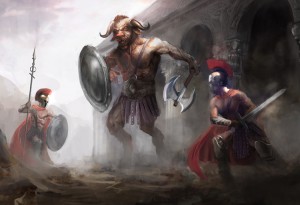Mythic Monday: the Minotaur of Crete
Monday, July 31st, 2017July 31, 2017
The star of this week’s Mythic Monday is the Minotaur, a fearsome monster from Greek mythology that was half man and half bull. The Minotaur was the oversized offspring of a bull and a woman named Pasiphae. Pasiphae was the wife of King Minos of Crete, who ruled the Aegean Sea and conquered much of Greece, including Athens. Daedalus, a skilled Athenian craftsman and inventor, created the Labyrinth–a place with many confusing paths and passageways–for King Minos, and it was used to imprison the Minotaur.

The Minotaur stands tall against Theseus in the monster’s final battle. Credit: © Vuk Kostic, Shutterstock
According to legend, Athens was forced to send seven youths and seven maidens to Crete every year as a sacrifice to the Minotaur (the monster would eat them). One year, Theseus, a mighty warrior and the son of an Athenian king, decided to go as one of the youths and try to kill the Minotaur. In a quick but brutal fight, Theseus managed to kill the monster and save the other Athenians from slaughter. With the help of Ariadne, he also found his way out of the twisting passages of the Labyrinth. Ariadne, Minos’ daughter, had given Theseus a ball of thread to unwind as he entered the maze. He followed the thread and escaped and saved his companions. Ariadne left Crete with Theseus, but he deserted her on the way back to Athens.
In modern times, archaeologists have discovered the remains of a palace that may have been the site of the Cretan Labyrinth. The palace is located in the city of Knossos, the ancient center of the Minoan civilization, which flourished on Crete and some Aegean Sea islands from about 3000 to 1100 B.C. The palace has many passageways and resembles the mythical Labyrinth. Many double axes were found at the palace. Most scholars believe that the word labyrinth came from labrys, which means double axe. Of course, no ancient remains of the mythical Minotaur have ever been found.
Knossos was first settled about 7000 B.C. The city’s first great palace was built around 2000 B.C., but an earthquake destroyed it 300 years later. A fire damaged a second palace around 1450 B.C. Knossos was the leading Greek city-state on Crete until the Romans conquered the island in 67 B.C.


